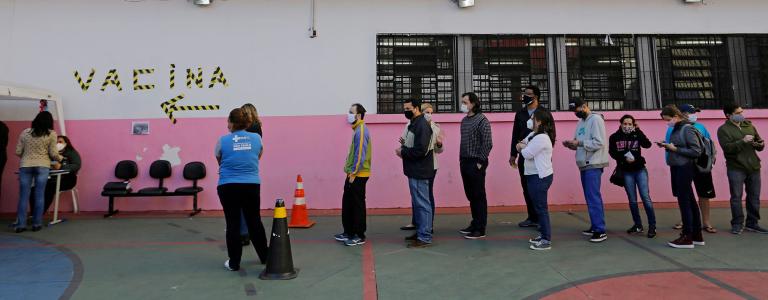WTO Lifts Trade Growth Forecasts, Says Poorer Nations Need Vaccines to Keep Up
The World Trade Organization has raised its growth forecast for global trade in merchandise for this year and 2022, but developing countries are lagging behind due to lower COVID-19 vaccination rates.
The World Trade Organization (WTO) raised its growth forecast for global trade in merchandise to 10.8% this year and 4.7% in 2022, approaching its pre-pandemic trend. But the Geneva-based trade body says developing countries are lagging behind more developed economies due to lower COVID-19 vaccination rates.
In March, the WTO predicted that goods trade would expand 8% this year and 4% in 2022. The high annual growth rate is largely due to the collapse in 2020, when trade bottomed out in the second quarter amid the pandemic. Global trade in goods declined 5.4% in 2020. The rate is expected to moderate next year as merchandise trade returns to the long-term trend it was on before the crisis struck.
Despite the “strong overall trade increase … there is significant divergence across countries,” the WTO said on October 4. Director-General Ngozi Okonjo-Iweala attributed this to inequitable access to vaccines.
“The longer vaccine inequity is allowed to persist, the greater the chance that even more dangerous variants of COVID-19 will emerge, setting back the health and economic progress we have made to date,” she said. “As we approach the 12th Ministerial Conference, members must come together and agree on a strong WTO response to the pandemic, which would provide a foundation for more rapid vaccine production and equitable distribution.”
Only 2.2% of people in low-income countries had received at least one dose of a COVID-19 vaccine as of October 4, the WTO said, citing a global database of vaccinations. Failure to vaccinate against the coronavirus in all countries has led to a “two-track recovery,” with slower growth in countries with limited access to vaccines—which are often those with the least fiscal space to support businesses and households. The WTO says this discrepancy creates space for the emergence and spread of new, potentially vaccine-evading forms of the virus, which could lead to the reimposition of health-related controls that reduce economic activity.
The Commonwealth of Independent States (CIS), the Middle East, and Africa are expected to have the weakest pandemic recoveries. Exports will grow 7% in Africa, 5% in the Middle East, and 0.6% in the CIS this year, the WTO said. Imports will expand 13.1% in the CIS, 11.3% in Africa, and 9.3% in the Middle East. Exports and imports of least developed countries will advance about 5.3% and 5.5%, respectively, this year.
“Annual trade growth figures for 2021 are to a considerable extent a function of the decline suffered by each region in 2020,” the WTO said.
The forecasts are still subject to risks ranging from inflation spikes and longer port delays to higher shipping rates and extended shortages of semiconductors. The rapid and unexpectedly strong recovery of demand in advanced and many emerging economies is hindering supply side disruptions, the WTO says. The pandemic itself presents potentially even bigger risks to world trade and output, especially if more deadly variants were to emerge, the WTO said, noting that the highly contagious Delta variant has already prompted some governments to reinstate some containment measures.
You might also be interested in
Senegal's Big LNG Gamble
This report explores Senegal's nascent liquefied nitrogen gas (LNG) industry by assessing the impacts associated with a new fossil fuel-based industry on the country's environment, economy, and society. It does this by responding to three questions: What have been the impacts of the development of LNG on Senegal to date? Is it viable for Senegal to invest further into an industry that is projected to decline? What risks can Senegal expect should it forge ahead with its LNG development plans?
Border Carbon Adjustment Mechanisms and Impacts on Vietnam
This report consolidates, analyzes, and presents views and perspectives of stakeholders from Vietnam on border carbon adjustment (BCA) schemes to contribute to the global debate on BCA good practices.
Avoiding a Trade Crisis as Countries Look to Phase Out Plastic Pollution
Why efforts to curb plastic pollution need to consider potential trade complications.
The United Kingdom's Strategy for Carbon Border Adjustment in a Changing Global Landscape
This report consolidates, analyzes, and presents views and perspectives of United Kingdom stakeholders on its proposed Carbon Border Adjustment Mechanism (CBAM) to contribute to the global debate on international principles and best practices for national border carbon adjustment schemes.
